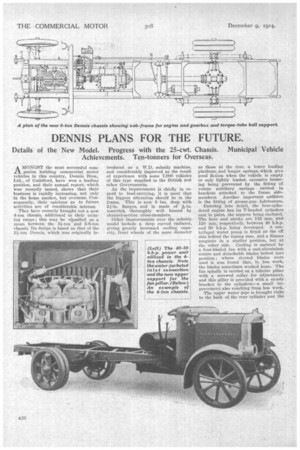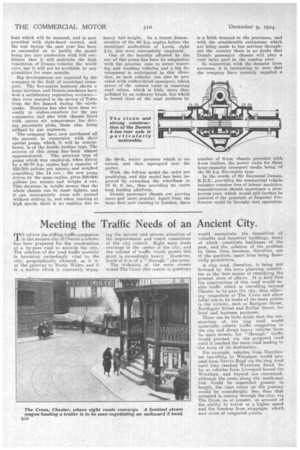DENNIS PLANS FOR THE FUTURE.
Page 12

Page 13

Page 14

If you've noticed an error in this article please click here to report it so we can fix it.
Details of the New Model. Progress with the 25-cwt. Chassis. Municipal Vehicle Achievements. Ten-tonners for Overseas.
AMONGST the most successful corapanies building commercial motor vehicles in this country, Dennis Bros., Ltd., of Guildford, have won a leading position, and their annual report, which was recently issued, shows' that their business is rapidly increasing, not only In the home market, but overseas. Consequently, their opinions as to future activities are of considerable interest. They have recently brought out a new 4-ton chassis, additional to their existing range; this may be classified as a mean between the 4-ton and 5-0-ton chassis. Its design is based on that of the ::4-ton Dennis, which was originally in
troduced as a W.D. subsidy machine, and considerably improved as the result of experience with some 7,000 vehicles of this type supplied to the British and other Governments.
As the improvement is chiefly in regard to load-carrying, it is meet that the biggest alteration should be in the frame. This is now 8 ins, deep with 2i-in. flanges, and is made of
materia14 thoroughly well braced by channel-section cross-members.
Other improvements over the subsidy model include a deep curved radiator, giving greatly increased cooling capacity, front wheels of the same diameter as those at the rear, a lower loading platform, and longer springs, which give good flexion when the vehicle is empty or only lightly loaded, excessive bouncing being prevented by the fitting of volute auxiliary -springs carried in brackets attached to the frame sidemembers. Another important addition is the fitting of grease-gun lubricators. Entering into detail, the four-cylitidered engine has its T-headed cylinders cast in pairs, the tappets being enclosed. The bore and stroke are 115 mm. and 150 mm. respectively, between 40 b.h.p. and 50 b.h.p. being developed. A centrifugal water pump is fitted at the off side behind the timing case, and a Simms magneto in a similar position, but at the other side. Cooling is assisted by a four-bladed fan with a east-aluminium centre and detachable blades bolted into position ; where riveted blades were 'used it was found that, in bus work, the blades sometimes worked loose. The fan spindle is carried on a tubular pillar with a screwed collar for adjustment, and this pillar is provided with a steady bracket to the cylinders—a sniall improvement also resulting from bus work. The upper water 'pipe is brought right to the back of the rear cylinder and the front pipe to the forward portion of the foremost cylinder, so that the water has to travel the whole length of the water jackets.
The clutch is of the, external cone type faced with Ferodo. It is provided with three external springs; which are easily adjustable, and ,gear-changing is facilitated by a spring-loaded clutch brake. Two fabric disc joints, each of three thicknesses, are utilized on the
clutch shaft. A
Four forward speeds are provided by the gearbox, which is an aluminium casting with a cover giving the maximum opening, and a smaller one for the introduction of lubricant. • The gear shafts run on ball bearings, and the gears are If the finest chrome nickel-steel ; 20 m.p.h. can be obtained on top gear, and the vehicle will climb a gradient of 1 in Ii with full load.
Behind the gearbox is a transmission brake of the loco type, with metal shoes having a large wearing surface. These shoes are centrally fulcrumed. On one end of each is a compression spring and at the other end a setscrew, so that they can be balanced and adjusted to uniform distances from the periphery of the drum. This metal-to-metal type of brake has proved most efficient and powerful, and when worn the shoes can be very easily changed.
Behind this brake is an enclosed Hooke-type joint, and a ring type with bushes is carried within the spherical housing of the torque tube. • • The thrust cross-member which carries the torque ball forms an excellent feature of the design. It is mounted in rubber-lined trunnions, so that all driving and braking shocks are transmitted through a cushion of rubber before reaching the frame proper.
The overhead worm drive has, of course, been retained. The standard ratios are 7i to 1, 9-66 to 1, according to requirements, Ind a specially low ratio of 10.25 to I can be supplied for overseas work. The axle easing is of cast steel, thoroughly ribbed, and the axle shafts can be withdrawn for removal of the differential and worm gearing without removing the wheels, all of which run on hardened and ground bear logs provided with phosphor-bronze floating bushes.
The whole design is particularly clean; for instance, in the lubrication system of the engine, no oil pipes are required for the connection between the plunger indicator and the crankcase, as the indicator is carried on a column, and merely protrudes through a hole in the dash without any actual connection to it.
A neat and practical method is employed for locating the springs on the axles. Each spring is provided with a horseshoe-shaped clip passing right round the bottom and sides of the spring ; the ends are forged round, screwed and passed through the upper spring plate, where they are nutted. This clip is located in a longitudinal slot in the spring bed of the axle, thus not only preventing any slipping of the axle, but greatly simplifying fitting and removal, as the spring can be taken away complete without separating the leaves.
It is interesting, also, to note that the clutch shaft, change-speed shaft and brake cross-shaft are all provided with bushes fitting into spherical housings, which obviate any tendency of binding through frame distortion.
Ball joints are employed for the "'steering rods, these being spring-loaded. The hand-brake drums on the rear wheels are of notable size ; they are bolted to the wheels and can be renewed if required.
As regards the other models manufactured by the company, great success has been achieved with the 2-24-tmi type, of which over 1,00() have been sold to the leading oil companies alone during the past 20 months.
There is no doubt that many of our load which will be imposed, and is now provided with right-hand control, and the test during the past year has been so successful as to justify the model being put into production with full confidence that it will maintain the high reputation of Dennis vehicles the world over, but it will not be available in any quantities for some months.
Big developments are expected by the company in the field of municipal transport. The fire-engine business shows a large increase, and Dennis machines have won a satisfactory reputation overseas-they even assisted in the saving of Tokio from the fire hazard during the earthquake. Business has also been done recently in siphon-emntiers for the gas companies, and also with chassis fitted with patent air compressors for driving pneumatic picks, these also being utilized by gas engineers.
The company have now purchased all the patents in connection with their special pump, which, it will be remembered, is of the double turbine type. The success of this pump has 'been almost unprecedented. The previous type of pump which was employed, when driven by a 60-70 h.p. engine had a capacity of 450-500 gallons per minute, and weighed something like 14 cwt. ; the new pump driven by the same engine, gives 500-600 gallons per minute and weighs 4 cwt. This decrease in weight means that the whole chassis can be made lighter, and it can consequently cross soft ground without sinking in, and when running at high speeds there is no snaking due to heavy tail weight. In a recent demonstration of the 60 h.p. engine.before the municipal authorities of Leeds, eight jets were successfully employed.
One of the benefits afforded by the use of this pump has been its adaptation with the greatest ease to street watering and washing vehicles, and a big development is anticipated in this direction, as such vehicles can also be provided with rubber-faced squeegees, which prove of the utmost value in removing road refuse, which is little more than polished by an ordinary brush, but which is forced clear of the road surfaces by the 60-th water pressure which is entamed, and then squeegeed into the gutter.
With the 5-6-ton model the sales are gratifying, and this model has been improved by extending the wheelbase to 15 ft_ 6 ins., thus providing an -extra long loading platform.
Dennis pas.senger chassis are proving more and more popular. Apart from the large fleet now running in London, there
is a brisk demand in the provinces, and with the considerable extensions which are being made in bus services throughout the country there is no doubt that Dennis passenger chassis will play a very large part in the coming year.
In connection with the demand from overseas, it is interesting to note that the company have recently supplied a
number of 6-ton chassis provided with 4-ton trailers, the power units for these large-capacity transport media being of the 60 h.p. fire-engine type.
In the words of Sir Raymond Dennis, K.B.E., providing the commercial vehicle industry remains free of labour anxieties, manufacturers should experience a prosperous year, which would still further be assisted if the principle of Imperial Preference could be brought into operation.






























